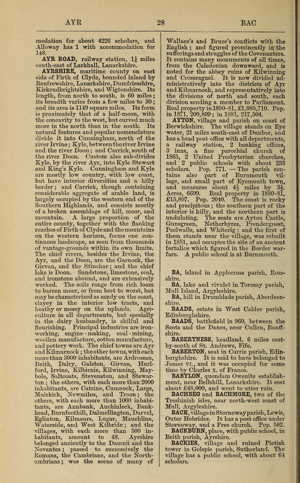page: 28 line: 6
AYRSHIRE, maritime county on east side of Firth of Clyde, hounded inland by Renfrewshire, Lanarkshire, Dumfriesshire, Kirkcudbrightshire, and Wigtonshire. Its length, from north to south, is 60 miles ; its breadth varies from a few miles to 30 ; and its area is 1149 square miles. Its form is proximately that of a half-moon, with the concavity to the west, but curved much more in the north than in the south. Its natural features and popular nomenclature divide it into Cunningham, north of the river Irvine ; Kyle, between the river Irvine and the river Doon ; and Carrick, south of the river Doon. Custom also sub-divides Kyle, by the river Ayr, into Kyle Stewart and King's Kyle. Cunningham and Kyle are mostly low country, with low coast, but have interior diversities and a hilly border ; and Carrick, though containing considerable aggregate of arable land, is largely occupied by the western end of the Southern Highlands, and consists mostly of a broken assemblage of hill, moor, and mountain. A large proportion of the entire county, together with the flanking reaches of Firth of Clyde and the mountains on the western horizon, forms one continuous landscape, as seen from thousands of vantage-grounds within its own limits. The chief rivers, besides the Irvine, the Ayr, and the Doon, are the Garnock, the Girvan, and the Stinchar ; and the chief lake is Doon. Sandstone, limestone, coal, and ironstone abound, and are extensively worked. The soils range from rich loam to barren moor, or from best to worst, but may be characterized as sandy on the coast, clayey in the interior low tracts, and heathy or mossy on the uplands. Agriculture in all departments, but specially in the dairy husbandry, is skilful and flourishing. Principal industries are iron-working, engine-making, coal-mining, woollen manufacture, cotton manufacture, and pottery work. The chief towns are Ayr ;i ml Kilmarnock ; the other towns, with each more than 3000 inhabitants, are Ardrossan, Keith, Dairy, Galston, Girvan, Hurlford, Irvine, Kilbirnie, Kilwinning, Maybole, Saltcoats, Stevenston, and Stewarton ; the others, with each more than 2000 inhabitants, are Catrine, Cumnock, Largs, Muirkirk, Newmilns, and Troon ; the others, with each more than 1000 inhabitants, are Annbank, Auchinleck, Bankhead, Burnfoothill, Dalmellington, Darvel, Eglinton, Kilmaurs, Lugar, Mauchline, Waterside, and West Kilbride ; and the villages, with each more than 300 inhabitants, amount to 48. Ayrshire belonged anciently to the Damnii and the Xovantes ; passed to successively the Romans, the Cambrians, and the North-umbrians; was the scene of many of Wallace's and Bruce's conflicts with the English ; and figured prominently in the sufferings and struggles of the Covenanters. It contains many monuments of all times, from the Caledonian downward, and is noted for the abbey ruins of Kilwinning and Crossraguel. It is now divided administratively into the districts of Ayr and Kilmarnock, and representatively into the divisions of north and south, each division sending a member to Parliament. Real property in 1880-81, 1,085,710. Pop. in 1871, 200,809 ; in 1881, 217,504.


